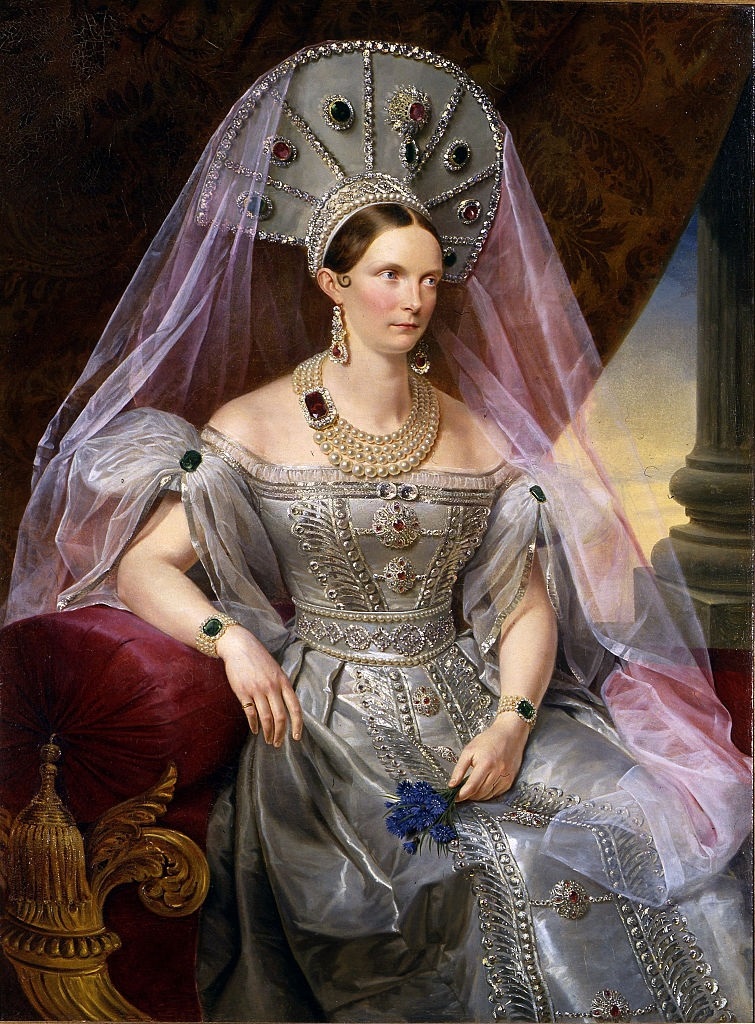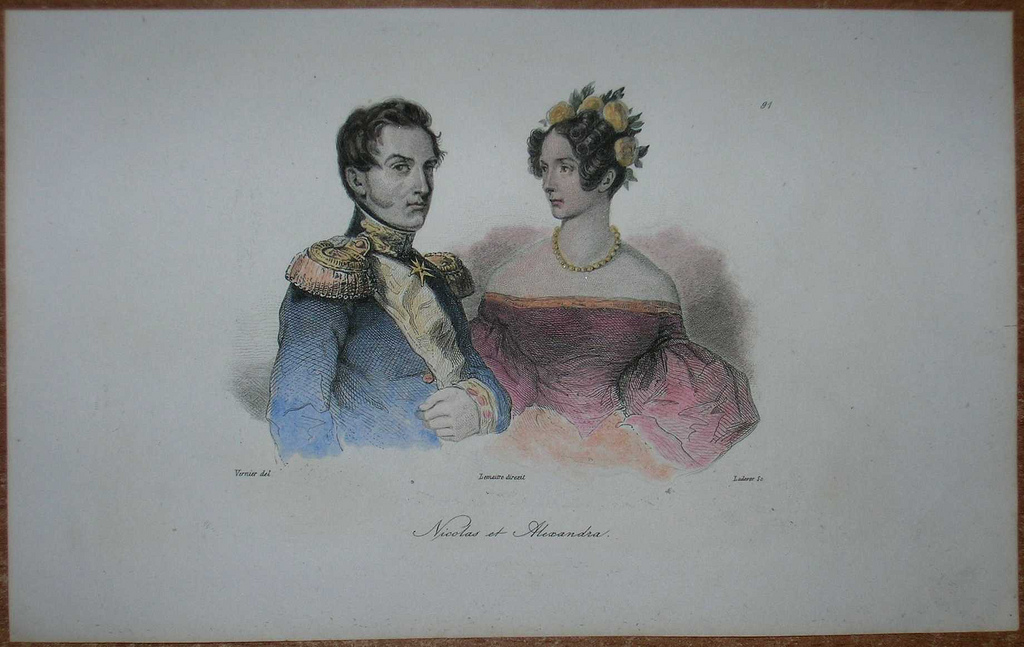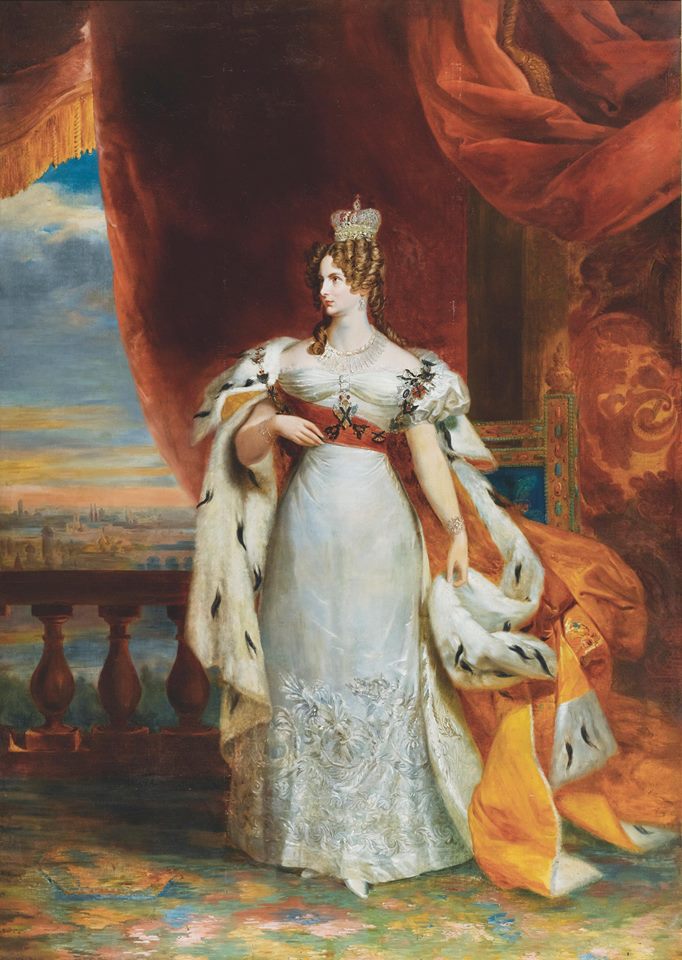by Susan Flantzer © Unofficial Royalty 2018

Charlotte of Prussia, Alexandra Feodorovna, Empress of All Russia; Credit – Wikipedia
Princess Charlotte of Prussia (Friederike Louise Charlotte Wilhelmina) was born in Potsdam in the Kingdom of Prussia, now in the German state of Brandenburg, on July 13, 1798. She was the eldest of the four daughters and the third of the nine children of King Friedrich Wilhelm III of Prussia and Luise of Mecklenburg-Strelitz. Charlotte’s two elder brothers both became Kings of Prussia and the younger of the two brothers was the first German Emperor.
Charlotte had eight siblings:
- King Friedrich Wilhelm IV of Prussia (1795 – 1861), married Elisabeth Ludovika of Bavaria, no children
- Wilhelm I, German Emperor, King of Prussia (1797 – 1888), married Augusta of Saxe-Weimar-Eisenach, had two children including Friedrich III, German Emperor, King of Prussia
- Frederica of Prussia (1799 – 1800), died in infancy
- Karl of Prussia (1801 – 1883), married Marie of Saxe-Weimar-Eisenach, had three children
- Alexandrine of Prussia (1803 – 1892), married Paul Friedrich, Grand Duke of Mecklenburg-Schwerin, had three children
- Ferdinand of Prussia (1804 – 1806), died of diphtheria in childhood
- Luise of Prussia (1808 – 1870), married Prince Frederik of the Netherlands, had four children
- Albrecht of Prussia (1809 – 1872), married (1) Princess Marianne of the Netherlands, had four children, divorced; (2) Rosalie von Rauch, morganatic marriage, had two children

Charlotte (leaning against her mother) with her parents and siblings in 1806; Credit – Wikipedia
Charlotte’s childhood was marked by the Napoleonic Wars. After the defeat of the Prussian troops in the Battle of Jena-Auerstedt in November 1806, Charlotte’s family was forced to flee Berlin. They settled in Königsberg, East Prussia (now Kaliningrad, Russia) under the protection of Alexander I, Emperor of All Russia, Charlotte’s future brother-in-law. After the fall of Berlin and its occupation, the family settled in Memel, Prussia (now Klaipėda, Lithuania). In December 1809, the family finally returned to Berlin but on July 19, 1810, Charlotte’s mother Queen Luise died from an unidentified illness at the age of 34, less than a week after Charlotte’s twelfth birthday. As the eldest daughter, Charlotte was now the first lady at the court and had to undertake her mother’s duties. Throughout her life, Charlotte maintained her connection to Prussia as well as the memory of her mother.

Charlotte at age 12; Credit – Wikipedia
In the autumn of 1814, Grand Duke Nicholas Pavlovich of Russia and his younger brother Grand Duke Michael Pavlovich, the two youngest brothers of Alexander I, Emperor of Russia, visited Berlin, Kingdom of Prussia, now in the German state of Brandenburg. When Charlotte and Nicholas met, it was love at first sight. In November 1815, arrangements were made for nineteen-year-old Nicholas to marry seventeen-year-old Charlotte to strengthen the alliance between Russia and Prussia. Alexander I, who was nineteen years older than Nicholas, had no surviving children but Nicholas was not expected to inherit the Russian throne as his elder brother Grand Duke Konstantin Pavlovich was the heir. Charlotte was glad that she would not be the empress and would be able to live away from palace intrigues.

Princess Charlotte of Prussia with her groom, Grand Duke Nicholas Pavlovich of Russia; Credit – Wikipedia
Charlotte arrived in Russia in June 1817. She converted to Russian Orthodoxy on July 6, 1817, and took the name Alexandra Feodorovna. The next day, she was officially engaged to Grand Nicholas Pavlovich and was created a Grand Duchess of Russia. The wedding was held on Alexandra Feodorovna’s 19th birthday, July 13, 1817, at the Grand Church of the Winter Palace in St. Petersburg, Russia.
Alexandra and Nicholas had seven children who would revive the Romanov dynasty:
- Alexander II, Emperor of All Russia (1818 – 1881), married (1) Marie of Hesse and by Rhine (Maria Alexandrovna), had six children including Alexander III and Maria Alexandrovna who married Alfred, Duke of Edinburgh, son of Queen Victoria; (2) Princess Catherine Dolgorukov, morganatic marriage, had four children
- Grand Duchess Maria Nikolaevna (1819 – 1876), married (1) Maximilian de Beauharnais, 3rd Duke of Leuchtenberg, had seven children; (2) Count Grigori Stroganov, morganatic marriage, had two children
- Grand Duchess Olga Nikolaevna (1822 – 1892), married 1846, Karl, King of Württemberg, no children
- Grand Duchess Alexandra Nikolaevna (1825 – 1844), married Prince Friedrich Wilhelm of Hesse-Kassel, had one son who died shortly after birth along with Alexandra
- Grand Duke Konstantin Nikolaevich (1827 – 1892), married Alexandra of Saxe-Altenburg (Alexandra Iosifovna), had six children including Olga Konstantinovna who married King George I of Greece
- Grand Duke Nicholas Nikolaevich (1831 – 1891), married Alexandra of Oldenburg (Alexandra Petrovna), had two children
- Grand Duke Michael Nikolaevich (1832 – 1909), married Cecilie of Baden (Olga Feodorovna); had seven children including Alexander Mikhailovich who married Grand Duchess Xenia Alexandrovna, daughter of Alexander III, Emperor of All Russia; three of Michael’s sons were killed by the Bolsheviks during the Russian Revolution

Alexandra Feodorovna with her two eldest children Maria and Alexander; Credit – Wikipedia
Alexandra and Nicholas’ marriage was truly built upon love and they found great pleasure in each other’s company. Alexandra studied Russian customs and language with the foremost poet of the time, Vasily Andreyevich Zhukovsky. She never mastered Russian because the Imperial Family spoke German (the current empress and dowager empress both came from German royal houses) and all their correspondence was in French. Alexandra had a good relationship with her mother-in-law Dowager Empress Maria Feodorovna (born Sophia Dorothea of Württemberg) but not with her sister-in-law Empress Elizabeth Alexeievna (born Luise of Baden). The problems between the two sisters-in-law may stem from Empress Elizabeth Alexeievna’s childlessness and Alexandra Feodorovna’s quickly growing family.

Alexandra Feodorovna, 1817; Credit – Wikipedia
Because Nicholas’ eldest brother Alexander I, Emperor of All Russia had no surviving children, the second brother Grand Duke Konstantin Pavlovich was the heir to the throne. Konstantin had married Juliane of Saxe-Coburg-Saalfeld in 1796. Juliane was very unhappy in the marriage, separated from Konstantin in 1799, and returned to her homeland permanently in 1801. In 1814, Konstantin tried to reconcile with Juliana but was firmly rebuffed. In 1815, Konstantin started a relationship with Polish noble Joanna Grudzińska, Princess of Łowicz. Finally, in 1820, after 19 years of separation, Konstantin and Juliana’s marriage was annulled by Alexander I. Two months later, Grand Duke Konstantin morganatically married Joanna Grudzińska. However, for Alexander I to give his approval to the marriage, Konstantin was required to forfeit his rights to the Russian throne in favor of his younger brother Nicholas. The decision was kept secret and was known only to a very close circle in Saint Petersburg.
When Alexander I told Alexandra and Nicholas that they were to be Emperor and Empress, they were taken aback. Nicholas wrote, describing his feelings, “My wife and I remained in a position which I can liken only to the sensation that would strike a man if he were going calmly along a comfortable road sown with flowers and with marvelous scenery on all sides when, suddenly, an abyss yawns wide beneath his feet, and an irresistible force draws him into it, without allowing him to step back or turn aside.”
On December 1, 1825, 47-year-old Alexander I, Emperor of All Russia died from typhus, not in St. Petersburg, but in Taganrog, Russia. Because of his wife’s health issues, Alexander and Elizabeth Alexeievna had been living in a warmer climate in Taganrog, Russia by the Sea of Azov, 1155 miles/1,858 km from St. Petersburg. The secrecy of the decision to replace Konstantin with Nicholas as heir to the throne backfired. Only three men, apart from the deceased Alexander I, were aware of his decision, and none of them was present in the Winter Palace when the news of Alexander’s death reached Saint Petersburg on December 9, 1825.

Nicholas I, Emperor of All Russia; Credit – Wikipedia
Military governor Mikhail Miloradovich persuaded the hesitant Nicholas to pledge allegiance to Konstantin, who then lived in Warsaw as the Viceroy of Poland. The State Council agreed with Miloradovich and all the troops stationed in Saint Petersburg recognized Konstantin as their Emperor. Konstantin, still in Poland, repeated his rejection of the throne and blessed Nicholas as the Emperor. However, Konstantin refused to come to Saint Petersburg, leaving the dangerous task of resolving the crisis to Nicholas.
Evidence of a revolt (called the Decembrist Revolt) being planned that would involve Russian army officers leading soldiers in revolt against Nicholas becoming Emperor, forced Nicholas to act. On December 26, 1825, Nicholas proclaimed himself Emperor of All Russia. By noon, the government and most of the troops of Saint Petersburg pledged allegiance to Nicholas but the Decembrists incited three thousand soldiers in support of Konstantin and took a stand on Senate Square in St. Petersburg. The battle in Senate Square cost over 1,200 lives, crushed the revolt, and resulted in 29-year-old Nicholas becoming the undisputed Emperor of All Russia, and Alexandra Feodorovna becoming Empress. Alexandra and Nicholas I were crowned at the Assumption Cathedral in the Moscow Kremlin on September 3, 1826. Nicholas ruled the Russian Empire in an authoritative and reactionary manner for 29 years.

Coronation portrait of Empress Alexandra Feodorovna; Credit – Wikipedia
Although Nicholas had mistresses and illegitimate children, his love for Alexandra continued. When part of the Winter Palace in St. Petersburg in 1837 caught on fire, Nicholas ordered that a small box with letters Alexandra had written him during their engagement be saved. Alexandra’s health had always been frail and she suffered several minor heart attacks. Nicholas had a villa built for Alexandra in the Crimea where the climate was warmer but because of the Crimean War, Alexandra only stayed there once. In 1854, Alexandra was very ill and close to death but she survived. However, the next year, Nicholas caught a chill, refused medical treatment, and developed pneumonia. He died at the age of 58 on March 2, 1855, at the Winter Palace. His eldest son succeeded him as Alexander II, Emperor of All Russia.

Alexandra Feodorovna in 1860; Credit – Wikipedia – Royal Collection RCIN 2907923
After Nicholas’ death, Alexandra Feodorovna shut herself up in the Alexander Palace at Tsarskoye Selo. She surrounded herself with her favorite ladies-in-waiting who read to her from the works of the German writers Schiller and Goethe. Empress Alexandra Feodorovna survived her husband by five years, dying at the age of 62 on November 1, 1860, at the Alexander Palace. She was buried next to her husband at the Cathedral of St. Peter and St. Paul in St. Petersburg, Russia.

Tomb of Empress Alexandra Feodorovna; Photo Credit – Автор: El Pantera – собственная работа, GFDL, https://commons.wikimedia.org/w/index.php?curid=364339
This article is the intellectual property of Unofficial Royalty and is NOT TO BE COPIED, EDITED, OR POSTED IN ANY FORM ON ANOTHER WEBSITE under any circumstances. It is permissible to use a link that directs to Unofficial Royalty.
Unofficial Royalty Tsardom of Russia/Russian Empire Resources
- Tsardom of Russia/Russian Empire Index
- Romanov Births, Marriages and Deaths
- Romanov Burial Sites
- Romanovs Killed During the Russian Revolution
- Romanovs Who Survived the Russian Revolution
Works Cited
- De.wikipedia.org. (2018). Charlotte von Preußen (1798–1860). [online] Available at: https://de.wikipedia.org/wiki/Charlotte_von_Preu%C3%9Fen_(1798%E2%80%931860) [Accessed 30 Jan. 2018].
- En.wikipedia.org. (2018). Alexandra Feodorovna (Charlotte of Prussia). [online] Available at: https://en.wikipedia.org/wiki/Alexandra_Feodorovna_(Charlotte_of_Prussia) [Accessed 30 Jan. 2018].
- Lincoln, W. Bruce. (1981). The Romanovs: Autocrats of All the Russias. New York, NY.: Doubleday
- Ru.wikipedia.org. (2018). Александра Фёдоровна (жена Николая I). [online] Available at: https://ru.wikipedia.org/wiki/%D0%90%D0%BB%D0%B5%D0%BA%D1%81%D0%B0%D0%BD%D0%B4%D1%80%D0%B0_%D0%A4%D1%91%D0%B4%D0%BE%D1%80%D0%BE%D0%B2%D0%BD%D0%B0_(%D0%B6%D0%B5%D0%BD%D0%B0_%D0%9D%D0%B8%D0%BA%D0%BE%D0%BB%D0%B0%D1%8F_I) [Accessed 30 Jan. 2018].
